The auto industry continues to shift toward electric vehicles (EVs), and while sales growth has slowed somewhat this year at many companies and in many markets, recent guidance shows that it may only be in the near-term. In a recent outlook of the global EV market, one publication has recently suggested that EV growth may be advancing substantially in some developing markets, while others have seen increased plugin hybrid EV (PHEV) sales.
BloombergNEF released its 2024 Electric Vehicle Outlook earlier this month, part of an annual report that takes an in-depth look annually at electrification, shared mobility, autonomous driving, and other factors affecting transport. The report is massive and is packed with insights, including data on themes like overall passenger EV sales, global market uptake, charging station deployment, and more.
Last month, Bloomberg data suggested that the ongoing EV sales slowdown in the U.S. may not last very long, and data from the outlet’s EVO report suggests that many countries didn’t see similar slowdowns in the first quarter of the year. In particular, the publication notes that certain developing EV markets, including Thailand, India, Turkey, and Brazil actually eclipsed record sales during Q1, while China remains the EV sales leader.
“China still dominates the global EV market, but sales are rising quickly elsewhere too,” writes BloombergNEF in the report’s executive summary. “Electric vehicles are no longer only a wealthy country phenomenon. Developing economies like Thailand, India, Turkey, Brazil and others are all experiencing record sales as more low-cost electric models are targeted at local buyers.”
Still, the report also notes that many automakers have softened near-term EV targets, including Tesla, Mercedes-Benz, General Motors, and Ford.
Despite this, oil displacement from the adoption of EVs continues to increase across vehicle segments, and the report says that sales of internal combustion engine (ICE) vehicles has peaked, with the overall ICE fleet expected to peak soon. The outlet predicts that global road transport oil demand will peak in 2027, while road transport emissions will peak in 2028.
Even the simple executive summary of the over-260-page financial report has a lot of important insights, and you can see many of BloombergNEF’s charts from the abridged intro and its web page detailing the new report below.
Credit: BloombergNEF | 2024 Electric Vehicle Outlook Credit: BloombergNEF | 2024 Electric Vehicle Outlook Credit: BloombergNEF | 2024 Electric Vehicle Outlook Credit: BloombergNEF | 2024 Electric Vehicle Outlook Credit: BloombergNEF | 2024 Electric Vehicle Outlook Credit: BloombergNEF | 2024 Electric Vehicle Outlook Credit: BloombergNEF | 2024 Electric Vehicle Outlook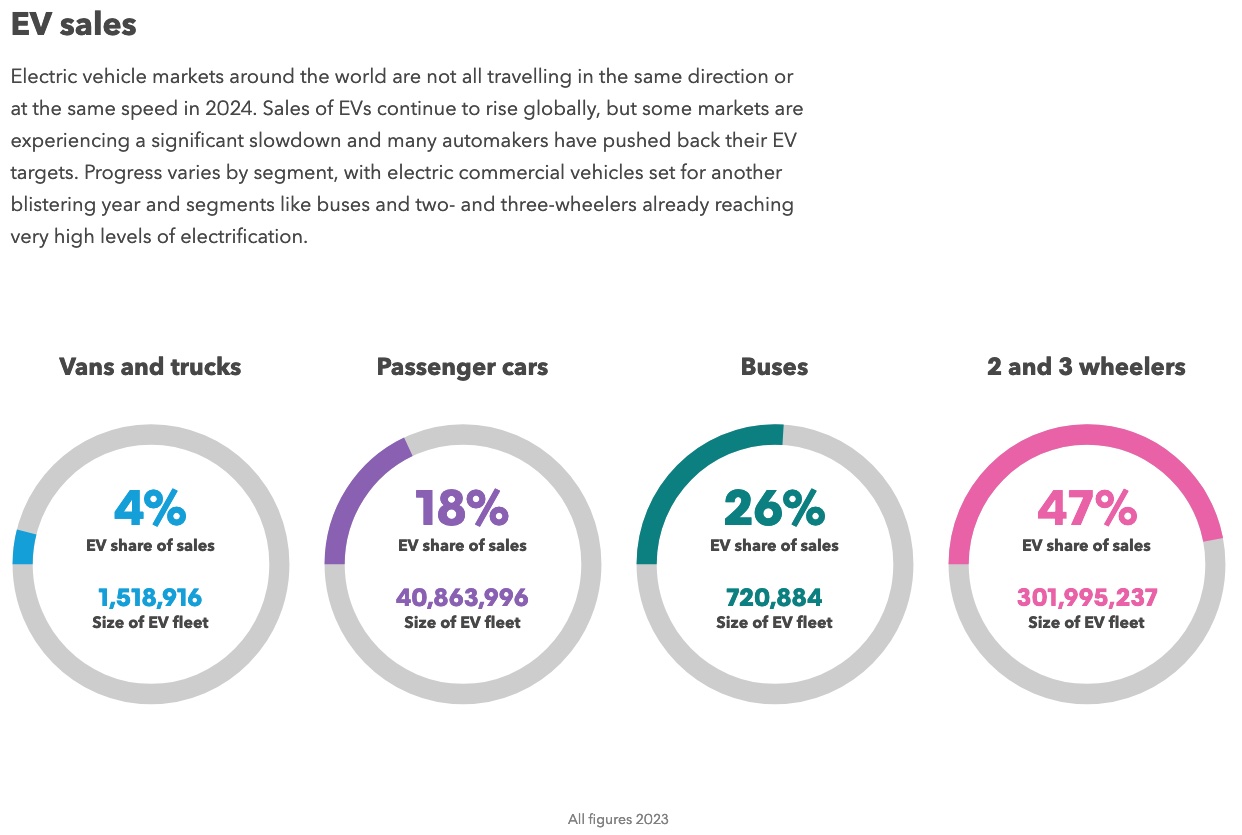
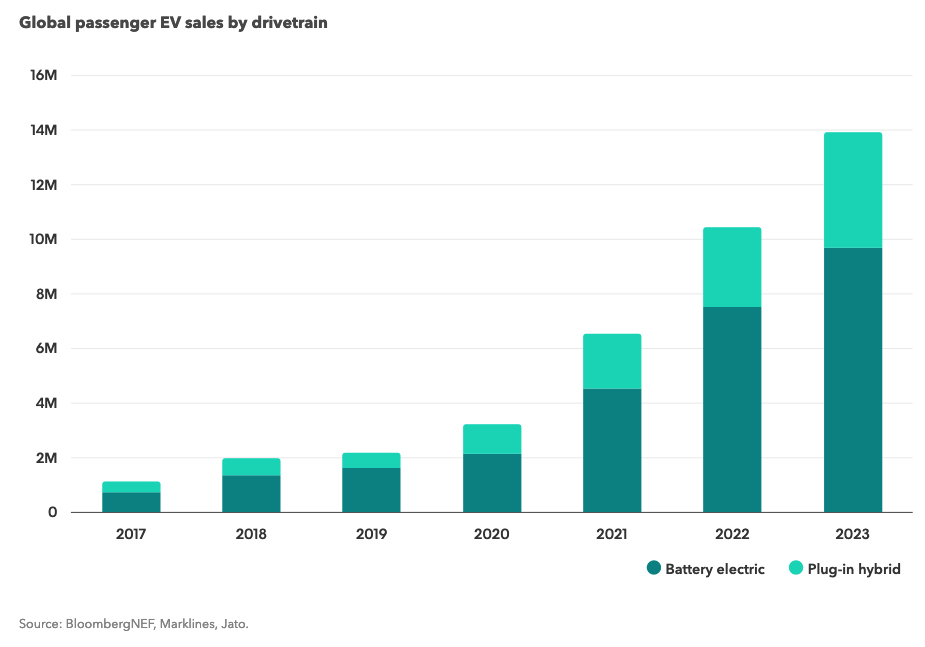
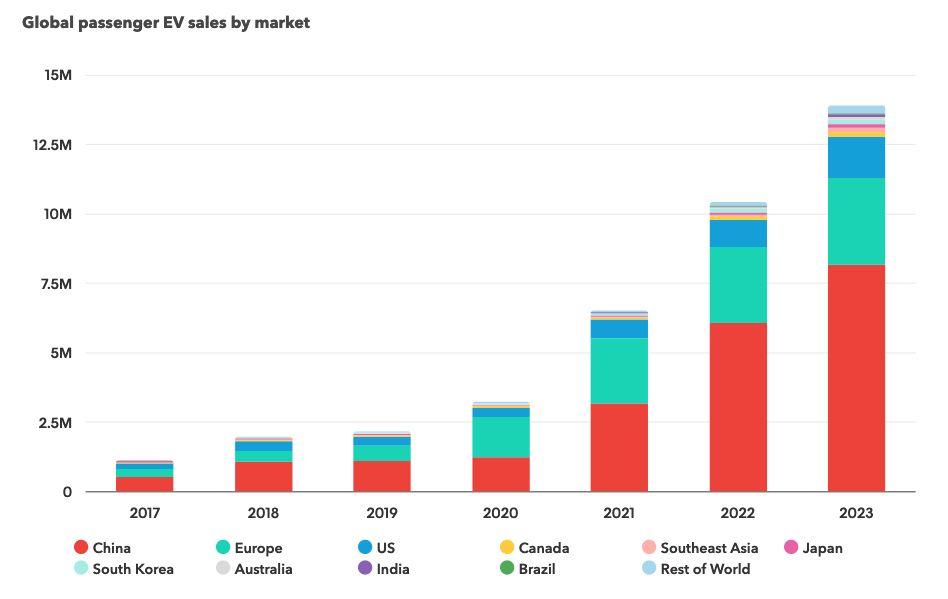
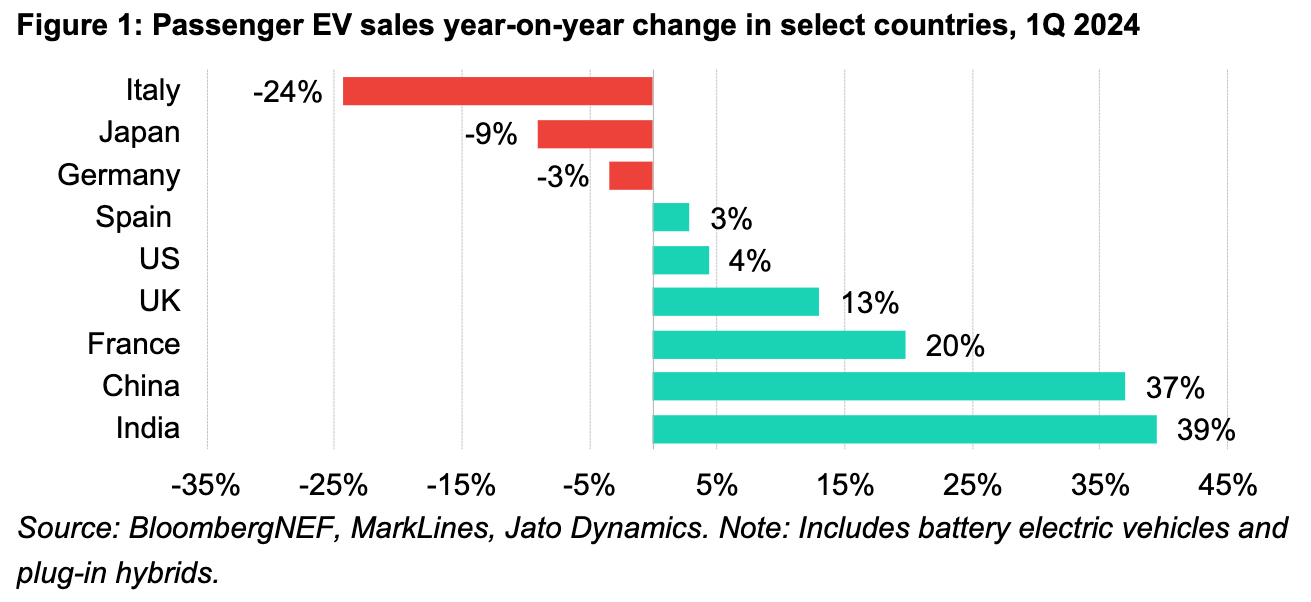
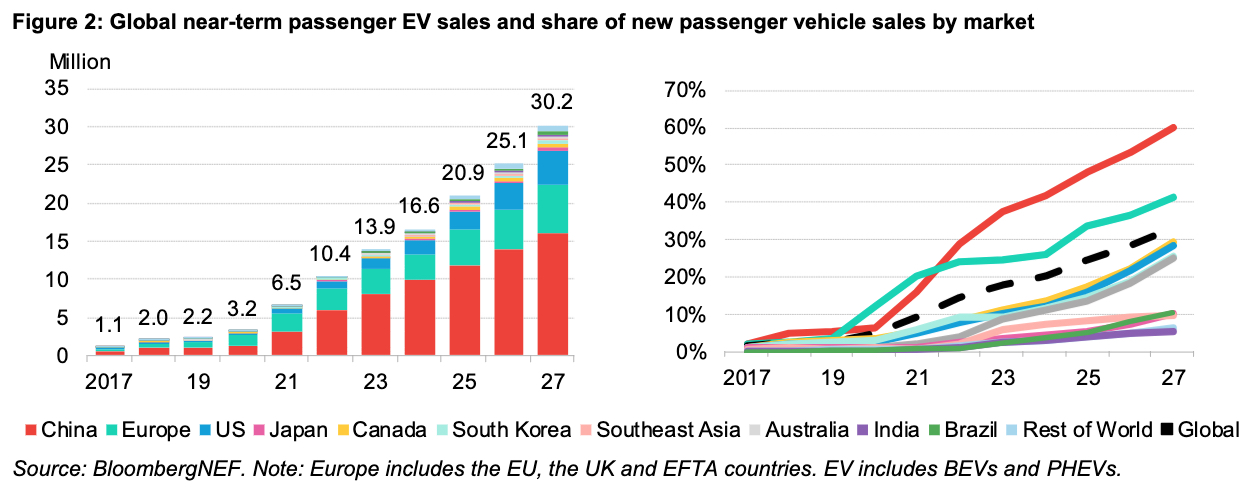
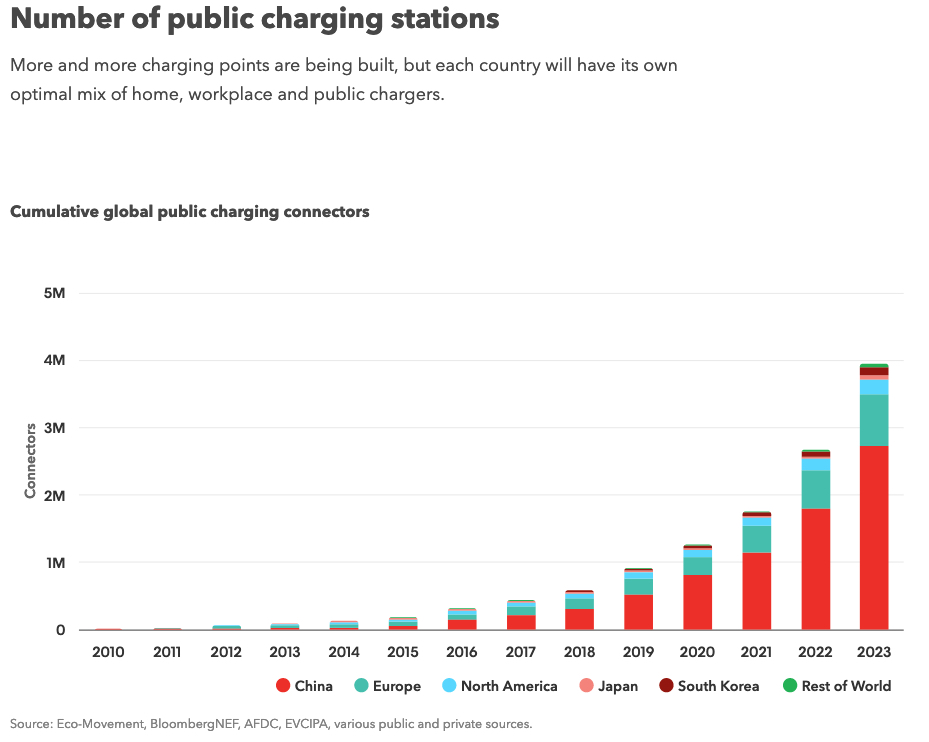
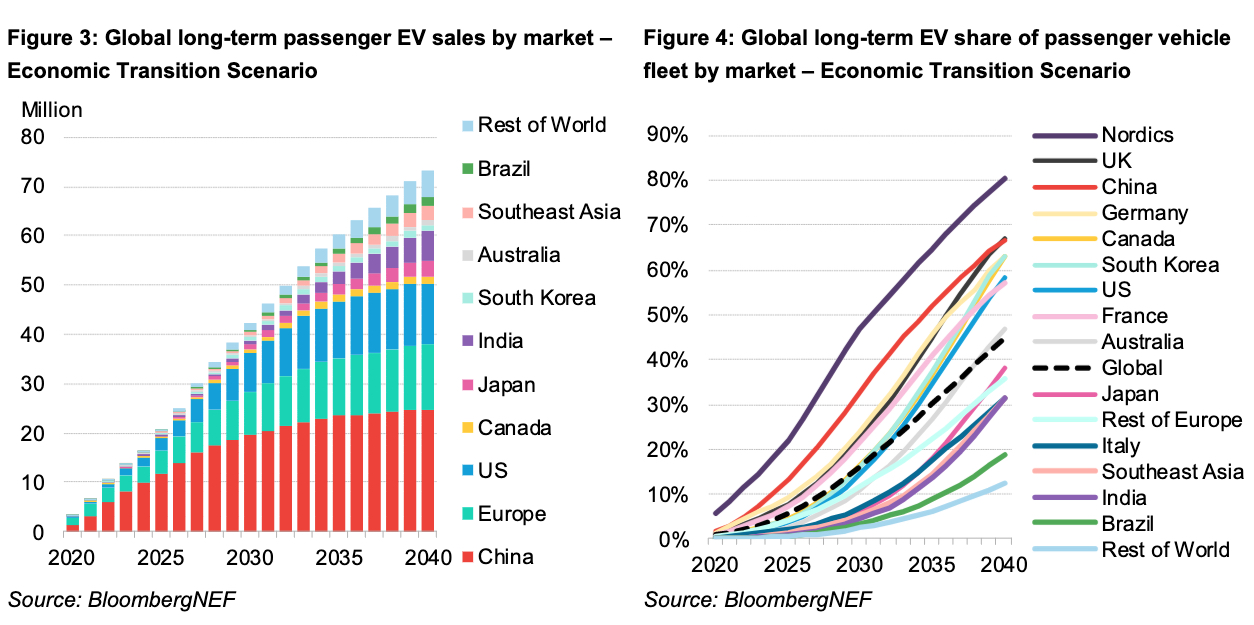
Check out the full summary of the BloombergNEF Electric Vehicle Outlook here, or use that link to request the full Executive Summary.
EVs to increase almost tenfold by 2030 under current policies: IEA
What are your thoughts? Let me know at zach@teslarati.com, find me on X at @zacharyvisconti, or send us tips at tips@teslarati.com.

News
Tesla FSD fleet is nearing 7 billion total miles, including 2.5 billion city miles
As can be seen on Tesla’s official FSD webpage, vehicles equipped with the system have now navigated over 6.99 billion miles.

Tesla’s Full Self-Driving (Supervised) fleet is closing in on almost 7 billion total miles driven, as per data posted by the company on its official FSD webpage.
These figures hint at the massive scale of data fueling Tesla’s rapid FSD improvements, which have been quite notable as of late.
FSD mileage milestones
As can be seen on Tesla’s official FSD webpage, vehicles equipped with the system have now navigated over 6.99 billion miles. Tesla owner and avid FSD tester Whole Mars Catalog also shared a screenshot indicating that from the nearly 7 billion miles traveled by the FSD fleet, more than 2.5 billion miles were driven inside cities.
City miles are particularly valuable for complex urban scenarios like unprotected turns, pedestrian interactions, and traffic lights. This is also the difference-maker for FSD, as only complex solutions, such as Waymo’s self-driving taxis, operate similarly on inner-city streets. And even then, incidents such as the San Francisco blackouts have proven challenging for sensor-rich vehicles like Waymos.
Tesla’s data edge
Tesla has a number of advantages in the autonomous vehicle sector, one of which is the size of its fleet and the number of vehicles training FSD on real-world roads. Tesla’s nearly 7 billion FSD miles then allow the company to roll out updates that make its vehicles behave like they are being driven by experienced drivers, even if they are operating on their own.
So notable are Tesla’s improvements to FSD that NVIDIA Director of Robotics Jim Fan, after experiencing FSD v14, noted that the system is the first AI that passes what he described as a “Physical Turing Test.”
“Despite knowing exactly how robot learning works, I still find it magical watching the steering wheel turn by itself. First it feels surreal, next it becomes routine. Then, like the smartphone, taking it away actively hurts. This is how humanity gets rewired and glued to god-like technologies,” Fan wrote in a post on X.
News
Tesla starts showing how FSD will change lives in Europe
Local officials tested the system on narrow country roads and were impressed by FSD’s smooth, human-like driving, with some calling the service a game-changer for everyday life in areas that are far from urban centers.

Tesla has launched Europe’s first public shuttle service using Full Self-Driving (Supervised) in the rural Eifelkreis Bitburg-Prüm region of Germany, demonstrating how the technology can restore independence and mobility for people who struggle with limited transport options.
Local officials tested the system on narrow country roads and were impressed by FSD’s smooth, human-like driving, with some calling the service a game-changer for everyday life in areas that are far from urban centers.
Officials see real impact on rural residents
Arzfeld Mayor Johannes Kuhl and District Administrator Andreas Kruppert personally tested the Tesla shuttle service. This allowed them to see just how well FSD navigated winding lanes and rural roads confidently. Kruppert said, “Autonomous driving sounds like science fiction to many, but we simply see here that it works totally well in rural regions too.” Kuhl, for his part, also noted that FSD “feels like a very experienced driver.”
The pilot complements the area’s “Citizen Bus” program, which provides on-demand rides for elderly residents who can no longer drive themselves. Tesla Europe shared a video of a demonstration of the service, highlighting how FSD gives people their freedom back, even in places where public transport is not as prevalent.
What the Ministry for Economic Affairs and Transport says
Rhineland-Palatinate’s Minister Daniela Schmitt supported the project, praising the collaboration that made this “first of its kind in Europe” possible. As per the ministry, the rural rollout for the service shows FSD’s potential beyond major cities, and it delivers tangible benefits like grocery runs, doctor visits, and social connections for isolated residents.
“Reliable and flexible mobility is especially vital in rural areas. With the launch of a shuttle service using self-driving vehicles (FSD supervised) by Tesla in the Eifelkreis Bitburg-Prüm, an innovative pilot project is now getting underway that complements local community bus services. It is the first project of its kind in Europe.
“The result is a real gain for rural mobility: greater accessibility, more flexibility and tangible benefits for everyday life. A strong signal for innovation, cooperation and future-oriented mobility beyond urban centers,” the ministry wrote in a LinkedIn post.
News
Tesla China quietly posts Robotaxi-related job listing
Tesla China is currently seeking a Low Voltage Electrical Engineer to work on circuit board design for the company’s autonomous vehicles.

Tesla has posted a new job listing in Shanghai explicitly tied to its Robotaxi program, fueling speculation that the company is preparing to launch its dedicated autonomous ride-hailing service in China.
As noted in the listing, Tesla China is currently seeking a Low Voltage Electrical Engineer to work on circuit board design for the company’s autonomous vehicles.
Robotaxi-specific role
The listing, which was shared on social media platform X by industry watcher @tslaming, suggested that Tesla China is looking to fill the role urgently. The job listing itself specifically mentions that the person hired for the role will be working on the Low Voltage Hardware team, which would design the circuit boards that would serve as the nervous system of the Robotaxi.
Key tasks for the role, as indicated in the job listing, include collaboration with PCB layout, firmware, mechanical, program management, and validation teams, among other responsibilities. The role is based in Shanghai.
China Robotaxi launch
China represents a massive potential market for robotaxis, with its dense urban centers and supportive policies in select cities. Tesla has limited permission to roll out FSD in the country, though despite this, its vehicles have been hailed as among the best in the market when it comes to autonomous features. So far, at least, it appears that China supports Tesla’s FSD and Robotaxi rollout.
This was hinted at in November, when Tesla brought the Cybercab to the 8th China International Import Expo (CIIE) in Shanghai, marking the first time that the autonomous two-seater was brought to the Asia-Pacific region. The vehicle, despite not having a release date in China, received a significant amount of interest among the event’s attendees.










